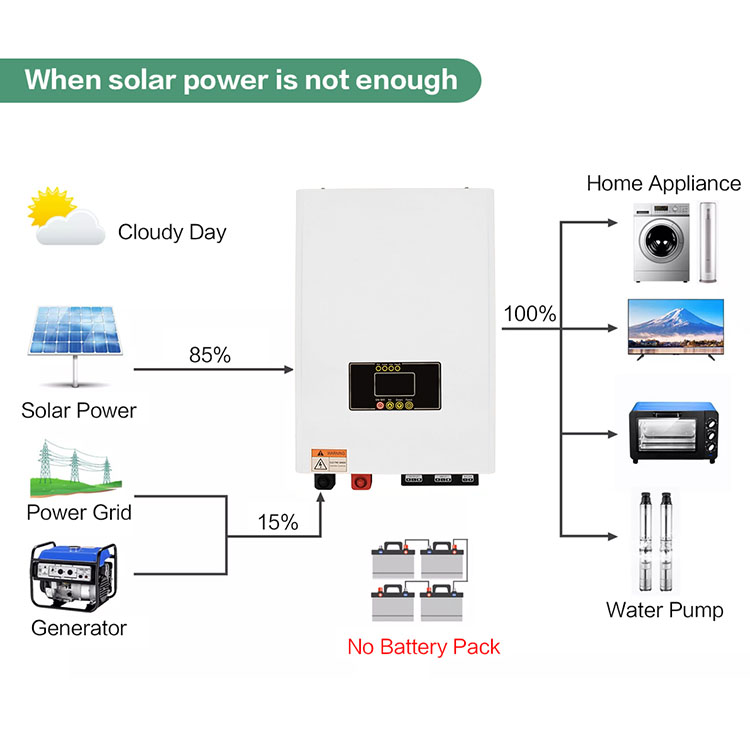The latest research on the solar inverter industry - four dimensions
 Jun 21,2022
Jun 21,2022

 Rekesun
Rekesun
According to different technical routes, it is mainly divided into centralized, series, distributed and micro solar inverters
Inverters can be classified according to different dimensions such as technical route, energy storage or not, output AC voltage phase number, and downstream application fields. in particular:
1 According to the technical route, it is divided into centralized inverter, series inverter, distributed inverter and micro inverter
2. According to whether energy storage is used, it is divided into photovoltaic grid-connected inverters and energy storage inverters
3. According to the number of phases of the output AC voltage, it is divided into single-phase inverter and three-phase inverter
4. According to the application in grid-connected power generation system or off-grid power generation system, it is divided into grid-connected inverter and off-grid inverter
5. According to the type of photovoltaic power generation applied, it is divided into centralized photovoltaic power generation inverters and distributed photovoltaic power generation inverters

The working principles and performance differences of different types of solar inverters make the downstream application fields different. In the above classification standards, the widely used classification method is to distinguish according to the technical route, mainly divided into centralized, series, distributed and micro inverters. The working principles of various inverters are different, specifically:
1 Centralized inverter: The DC power generated by the photovoltaic modules is converted after the DC power is large. Such inverters have high power, and the unit capacity is generally above 500kW. It has the advantages of high output power, mature technology, high power quality and low cost, but it also has the disadvantage of insufficient MPPT tracking accuracy. A dedicated computer room with ventilation and heat dissipation is required. Therefore, this variety is usually used in centralized ground-based large-scale photovoltaic power plants with uniform lighting. Representative companies in the field of centralized inverter production include Sungrow Power, Shangneng Electric, etc.
2. Series inverter: Several groups of photovoltaic series (generally 1-4 groups) track the maximum power peak respectively, and then connect to the AC grid after inverter. The power of this inverter is relatively small, and the power of a single unit is generally below 100kW. With technological progress and the increasing demand for cost reduction and efficiency improvement, the power of series inverters has gradually increased, and there are high-power products such as 136kw and 175kW.
The series inverters have the advantages of a large number of MPPTs, high tracking accuracy, large power generation, flexible module configuration, and convenient installation. Mainly used for small household distributed power generation, small and medium-sized industrial and commercial rooftop power stations, and can also be used for centralized photovoltaic power generation systems. Representative companies in the field of series inverter production include Goodway, Jinlong Technology, Growatt, etc.
3. Distributed inverter: Multiple MPPT control optimizers are used in the front to realize the multi-channel MPPT optimization function. After convergence, the inverter adopts a centralized inverter. This inverter combines the advantages of "centralized inverter" of large-scale centralized photovoltaic inverters and "decentralized MPPT tracking" advantages of series photovoltaic inverters, and realizes the low-cost, high-efficiency of centralized inverters. Reliability and high power generation from series inverters.
4. Micro-inverter: track the maximum power peak of each photovoltaic module respectively, and connect to the AC grid after inversion. The single capacity of this inverter is generally less than 1kW. It has the advantages of independent maximum power tracking control for each module, which improves the overall efficiency in the event of shadows or component performance differences, and minimizes potential safety hazards, but also has the advantages of high price and difficult maintenance after failure. It is suitable for Small projects.
Energy storage is the key support for the large-scale development of renewable energy. Energy storage is of great significance to the utilization of new energy and is an important part of the energy revolution. For example, for photovoltaic power generation, as an intermittent energy source, the fluctuation of power generation will bring impact to the power grid system, and the integration of optical storage can restrain the impact to a certain extent, which is conducive to flexible grid connection and full absorption of photovoltaic power generation. . The role of energy storage in the power system is mainly divided into three categories:
1 Power generation side: stable power generation, reducing the application of wind and light suppression, mainly to solve the volatility and consumption of grid-connected renewable energy power generation
2. Transmission and distribution side: improve power quality, realize frequency regulation and peak regulation, and improve the utilization rate of renewable energy
3. User side: peak and valley filling, emergency power supply, load smoothing, power grid expansion, increase power generation efficiency, and reduce power consumption costs
The energy storage inverter is an indispensable link in the energy storage system industry chain. In terms of energy storage inverter efficiency, the inverter integrates the functions of photovoltaic grid-connected power generation and energy storage power stations: it overcomes the shortcomings of unstable power generation of photovoltaic modules due to weather changes, and improves the quality of the power grid; The peak output power greatly reduces the peak power generation of the power grid, greatly increases the power grid capacity, and improves the grid utilization rate.
Both domestic and foreign policies have driven the increase in the installed capacity of energy storage. In the short term, the increase in installed energy storage capacity is mainly driven by national policies. From a global perspective, different countries have adopted different policies to promote the large-scale development of the energy storage industry, which can be divided into:
1 In countries or regions where energy storage has not yet been popularized or has just started, the development of energy storage has been gradually incorporated into the national strategic plan, and the government has begun to formulate a roadmap for energy storage development2. In countries or regions where energy storage has a certain scale or a relatively developed industry, the government often adopts tax incentives or subsidy measures to reduce the cost of energy storage and promote large-scale application.
3. In countries or regions where energy storage has gradually entered the auxiliary service market, the government has created a platform for energy storage applications by opening up the regional power market, realizing multiple values and providing high-quality services. From China's perspective, energy storage is an important part of China's strategic emerging industries. In recent years, national and local governments have issued a series of incentive policies to prepare for the development of the energy storage industry and gradually push the industry into a stage of large-scale development.
Market space calculation: The global inverter market will reach 85.6 billion yuan in 2025



 Home
Home What is a high frequency inverter and what should be paid attention to when using it?
What is a high frequency inverter and what should be paid attention to when using it? 







 syplighting.en.alibaba.com
syplighting.en.alibaba.com



